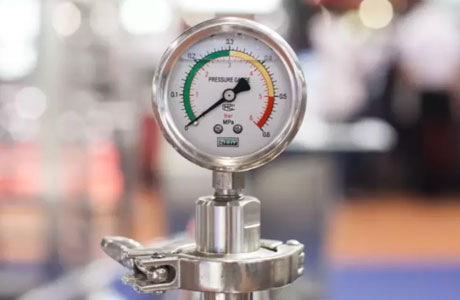What Is The Difference Between Gauge Pressure And Absolute Pressure?
Key Takeaway
Gauge pressure measures pressure relative to atmospheric pressure, while absolute pressure measures pressure relative to a perfect vacuum.
For example, at sea level, atmospheric pressure is 14.7 psi. If a system has 30 psi gauge pressure, its absolute pressure is 30 psi + 14.7 psi = 44.7 psi. Absolute pressure is used in scientific calculations, while gauge pressure is practical for industrial use.
Definition of Gauge Pressure vs. Absolute Pressure
Gauge pressure and absolute pressure are two distinct concepts in the field of pressure measurement, each with its own definition and applications. Gauge pressure refers to the pressure of a system relative to atmospheric pressure, while absolute pressure is the total pressure exerted by a fluid, including atmospheric pressure.
Understanding the difference between these pressures is crucial for accurate measurement and application. In practical scenarios, gauge pressure is often used in applications where atmospheric pressure is constant and can be ignored. However, in situations where pressure changes significantly, absolute pressure measurements are necessary for precision. By grasping the definitions and uses of these pressures, professionals can ensure accurate data collection and analysis, leading to improved system performance and safety.

Key Differences in Measurement
The primary difference between gauge pressure and absolute pressure lies in the reference point used for measurement.
1. Reference Point:
Gauge Pressure: Measured relative to atmospheric pressure. It can be negative when the internal pressure is less than the atmospheric pressure, which is common in vacuum systems.
Absolute Pressure: Measured relative to a perfect vacuum. It cannot be negative, as it includes the atmospheric pressure as part of its total measurement.
2. Pressure Range:
Gauge Pressure: Ranges from negative values (in cases of vacuum) to positive values, as it is calculated relative to atmospheric pressure.
Absolute Pressure: Always positive, as it is measured from a vacuum.
3. Measurement Context:
Gauge Pressure: Often used in everyday applications where only the pressure difference relative to the atmosphere matters, such as tire pressure, water tanks, and industrial systems.
Absolute Pressure: Used in scientific and engineering contexts where total pressure is essential, such as in deep-sea applications, vacuum chambers, and certain industrial processes.
Applications Where Each Type is Used
Gauge Pressure Applications:
Automotive Industry: Tire pressure is measured in terms of gauge pressure. This is because the pressure inside the tire is compared to the atmospheric pressure, helping to assess whether the tire is over or under-inflated.
HVAC Systems: The pressure of refrigerants and air is monitored using gauge pressure to ensure efficient system operation.
Hydraulic and Pneumatic Systems: These systems typically measure gauge pressure to monitor the pressure levels of fluids or gases, ensuring that the systems operate within safe parameters.
Absolute Pressure Applications:
Vacuum Systems: In processes where a perfect vacuum is necessary (e.g., semiconductor manufacturing), absolute pressure readings are used to measure the total pressure in the system.
Deep-sea Exploration: In underwater environments, the absolute pressure is used to understand the total pressure exerted by the water, including atmospheric pressure at the surface.
Scientific Research: Experiments that require precise pressure measurements often rely on absolute pressure to account for every pressure variable, including atmospheric influences.
Examples to Illustrate the Differences
Let’s consider a simple example to help clarify the difference:
Imagine you’re inflating a balloon. The gauge pressure inside the balloon would tell you how much pressure is inside the balloon compared to the surrounding air (atmospheric pressure). If your gauge reads 20 psi, it means the pressure inside the balloon is 20 psi higher than the atmospheric pressure.
On the other hand, if you were measuring the absolute pressure in the balloon, the reading would include both the 20 psi above atmospheric pressure and the atmospheric pressure itself (about 14.7 psi at sea level). So, the total absolute pressure in the balloon would be approximately 34.7 psi.
This example shows how gauge pressure reflects the difference between internal and atmospheric pressures, while absolute pressure provides the total measurement, including the influence of the atmosphere.
Importance of Understanding Both Concepts
Understanding the difference between gauge and absolute pressure is critical for accurate measurements in various fields. For industries like automotive, manufacturing, and HVAC, gauge pressure is sufficient for everyday operations. However, in more sensitive applications, such as vacuum chambers or deep-sea exploration, absolute pressure is essential for ensuring the precision of measurements and system safety.
Having a solid understanding of these two pressure types helps engineers, scientists, and technicians choose the right instruments and methods for pressure measurement. Whether you’re calibrating a pressure gauge, setting up an industrial system, or conducting scientific research, knowing when and why to use gauge versus absolute pressure is key to ensuring safety, efficiency, and accuracy.
Conclusion
In conclusion, gauge pressure and absolute pressure are two fundamental concepts in pressure measurement. Gauge pressure refers to the pressure relative to atmospheric pressure, while absolute pressure is measured relative to a perfect vacuum. Understanding the difference between these two is crucial for accurate pressure measurements and ensuring safety in various applications.
When selecting pressure measuring instruments, it’s essential to consider whether gauge or absolute pressure is required for the specific application. By doing so, you can prevent possible errors in readings and maintain the integrity of the operations, ultimately leading to more efficient and safer processes.

